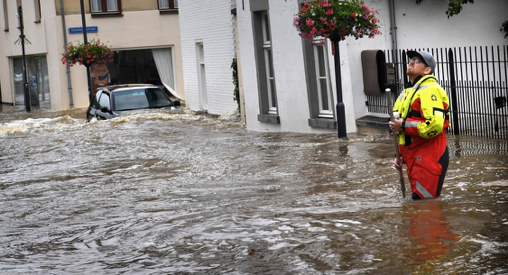TU Delft projects: Storm Surge Barriers, Floodings, Coastal Inundation and Breach Growth
- 23 June 2022
- Francien Horrevorts
- Knowledge Infrastructure
What can we learn from the Limburg floodings of summer 2021 and how can foreshores influence breach growth? These are two examples of research questions of Delft University of Technology (TU Delft) projects. Stephan Rikkert, postdoctoral researcher in the field of Hydraulic Engineering, explains more about some projects his department has been working on or is currently working on.
Storm Surge Barriers
TU Delft is working on the topic Storm Surge Barriers in close cooperation with Rijkswaterstaat. Typical examples of large storm surge barriers are the Maeslant barrier, the Thames barrier and the Venice barrier. The research topics included are the effects of climate change on storm surge barriers and adaptability, maintenance optimisation and knowledge management of the storm surge barriers.

Limburg Floodings in 2021
In the summer of 2021, extreme flooding occurred in Germany, Belgium and the Netherlands border area. In the Netherlands, the flooding occurred in Limburg, a southern province of the Netherlands. Unexpected summer floods took place due to a record amount of rainfall: 180 mm in 48 hours. This resulted in the highest discharge of the river Meuse ever recorded and record discharges in tributaries. Belgium and Germany had been hit harder by these floods, as the areas were larger, the rainfall was even more extreme and the hills were steeper. This resulted in bigger and faster flood waves. Researchers and experts from various institutions and companies aimed to find out what had happened to learn from it in order to prevent or minimise the consequences for the future. The lessons learned:
- Prepare for unexpected and extreme scenarios;
- Improve flood warning;
- River Floods: re-evaluate likelihood and river system performance;
- Reduce flood risk in tributaries and raise protection levels.
More details can be found in the research report (Summary in English, report in Dutch).

Photo: Marcel van den Berg - Limburg floodings 2021
Coastal Inundation in Bangladesh
The Coastal Inundation project in Bangladesh is a World Bank-funded project that is currently in progress. This project focusses on the coastal polders in Bangladesh, which are prone to flooding., as the area is subject to cyclones. The consequences of these natural disasters can be immense. The goal of this project is to provide guidance on inundation modelling of coastal polders. Often, the quick estimates of the flood extent and inundation depths are based on a conservative approach, called the “bathtub approach”. It assumes a certain protection level of the levee. If the water exceeds this protection level, the levee fails, resulting in a water level in the polder that is similar to the peak sea or river water level. If the levee is not failing, the polder remains dry.
This approach leads to overestimation of the flood extent and the inundation depth. The project team developed a new modelling approach, that better takes into account the characteristics of the hazard, flood protection structure and the polder. By considering the failure probability of levees, the number of expected breaches can be estimated. The number of breaches that occur during an event has a significant effect on the inflow to the polder, and hence the flood extent and depth of the inundation. The developed modelling approach shows a significantly lower inundation depth for water levels with relatively high return periods (lower than 100 years) for the studied cases.
Influence of foreshores on Breach Growth
From earlier research by Zhu et al (2020), it was concluded that the breach size and depth was limited if foreshores were present compared to places without a foreshore. This has consequences for the discharge entering the polder and for the flooding. Mario van den Berg started his research in order to find out how the foreshores affect breach growth. The first experiments have been performed in a lab setup. The erosion velocity of different foreshore material, such as sand, clay and vegetated foreshore was tested. A new series of full-scale breach experiments is currently being performed in Flood Proof Holland, a testing facility of TU Delft for Flood Risk Management research. Mario tests the effect of foreshores, made of different materials, on breach growth and how they erode.
Join a Breach Growth Experiment on 27 June
Do you want to visit one of the breach growth experiments live? Join us on the 27th of June in Flood Proof Holland.
>> Register for the Breach Growth Experiment
Full presentation
For more detailed information, watch the full presentation by Stephan Rikkert:
More information
To learn more about TU Delft, what they do and their role in Polder2C’s, read the interview with Stephan Rikkert.
